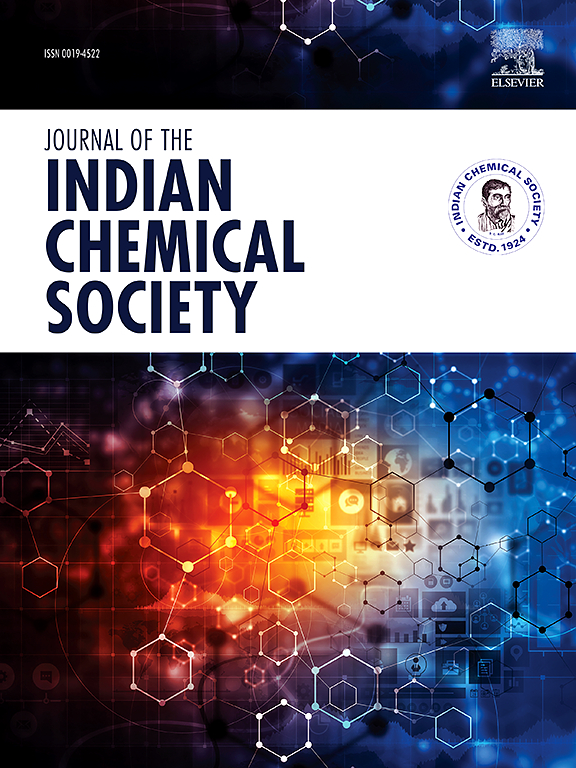Potentially toxic elements removal from aqueous solution using green synthesized ZnCo2O4 nanoparticles: a comparative study of adsorption isotherm and kinetic using linear and non-linear models
IF 3.4
4区 化学
Q2 CHEMISTRY, MULTIDISCIPLINARY
引用次数: 0
Abstract
ZnCo2O4 nanoparticles were synthesized by Aloe vera extract, and its characteristic was investigated using Fourier transform infrared spectroscopy (FT-IR), X-ray diffraction (XRD), scanning electron microscopy (SEM) and transmission electron microscopy (TEM). Also, the thermal characteristic of ZnCo2O4 nanoparticles was studied by thermogravimetric analysis (TGA). The capacity of ZnCo2O4 nanoparticles toward elimination of potentially toxic elements from aqueous media have been investigated by atomic absorption spectroscopy (AAS). The effect of various parameters including contact time, adsorbent mass, pH and initial metal concentration on the adsorption process have been investigated. Potentially toxic elements were removed using ZnCo2O4 nanoparticles, achieving maximum removal efficiencies of 92, 84, 60, and 50 % for Ni2+, Co2+, Cd2+, and Pb2+, respectively. A comparative analysis of linear and non-linear regression techniques for predicting optimal isotherms was conducted utilizing experimental adsorption equilibrium data. Various adsorption isotherm models, including Langmuir, Freundlich, Redlich-Peterson and Temkin were employed to analyze the experimental data. The findings indicated that the Langmuir equation provided a superior fit for the adsorption isotherms in the context of linear regression, whereas the Redlich-Peterson model demonstrated better fitting in non-linear regression. Kinetic modeling revealed that non-linear pseudo-second-order and Elovich models best describe the adsorption behavior of potentially toxic metal ions onto ZnCo2O4 nanoparticles, with contributions from both chemisorption and intraparticle diffusion mechanisms.

绿色合成纳米ZnCo2O4去除水中潜在有毒元素:线性和非线性模型吸附等温线和动力学的比较研究
以芦荟提取物为原料合成了纳米ZnCo2O4,并利用傅里叶变换红外光谱(FT-IR)、x射线衍射(XRD)、扫描电镜(SEM)和透射电镜(TEM)对其进行了表征。利用热重分析(TGA)研究了纳米ZnCo2O4的热特性。采用原子吸收光谱法(AAS)研究了纳米ZnCo2O4对水中潜在有毒元素的去除能力。考察了接触时间、吸附剂质量、pH和初始金属浓度等参数对吸附过程的影响。ZnCo2O4纳米颗粒对Ni2+、Co2+、Cd2+和Pb2+的去除率分别达到92%、84%、60%和50%。利用实验吸附平衡数据,对预测最佳等温线的线性和非线性回归技术进行了比较分析。采用Langmuir、Freundlich、Redlich-Peterson和Temkin等吸附等温线模型对实验数据进行了分析。结果表明,Langmuir方程对吸附等温线的线性拟合效果较好,而Redlich-Peterson模型对吸附等温线的非线性拟合效果较好。动力学模型表明,非线性伪二阶和Elovich模型最能描述潜在有毒金属离子在ZnCo2O4纳米颗粒上的吸附行为,化学吸附和颗粒内扩散机制都有贡献。
本文章由计算机程序翻译,如有差异,请以英文原文为准。
求助全文
约1分钟内获得全文
求助全文
来源期刊
CiteScore
3.50
自引率
7.70%
发文量
492
审稿时长
3-8 weeks
期刊介绍:
The Journal of the Indian Chemical Society publishes original, fundamental, theorical, experimental research work of highest quality in all areas of chemistry, biochemistry, medicinal chemistry, electrochemistry, agrochemistry, chemical engineering and technology, food chemistry, environmental chemistry, etc.

 求助内容:
求助内容: 应助结果提醒方式:
应助结果提醒方式:


